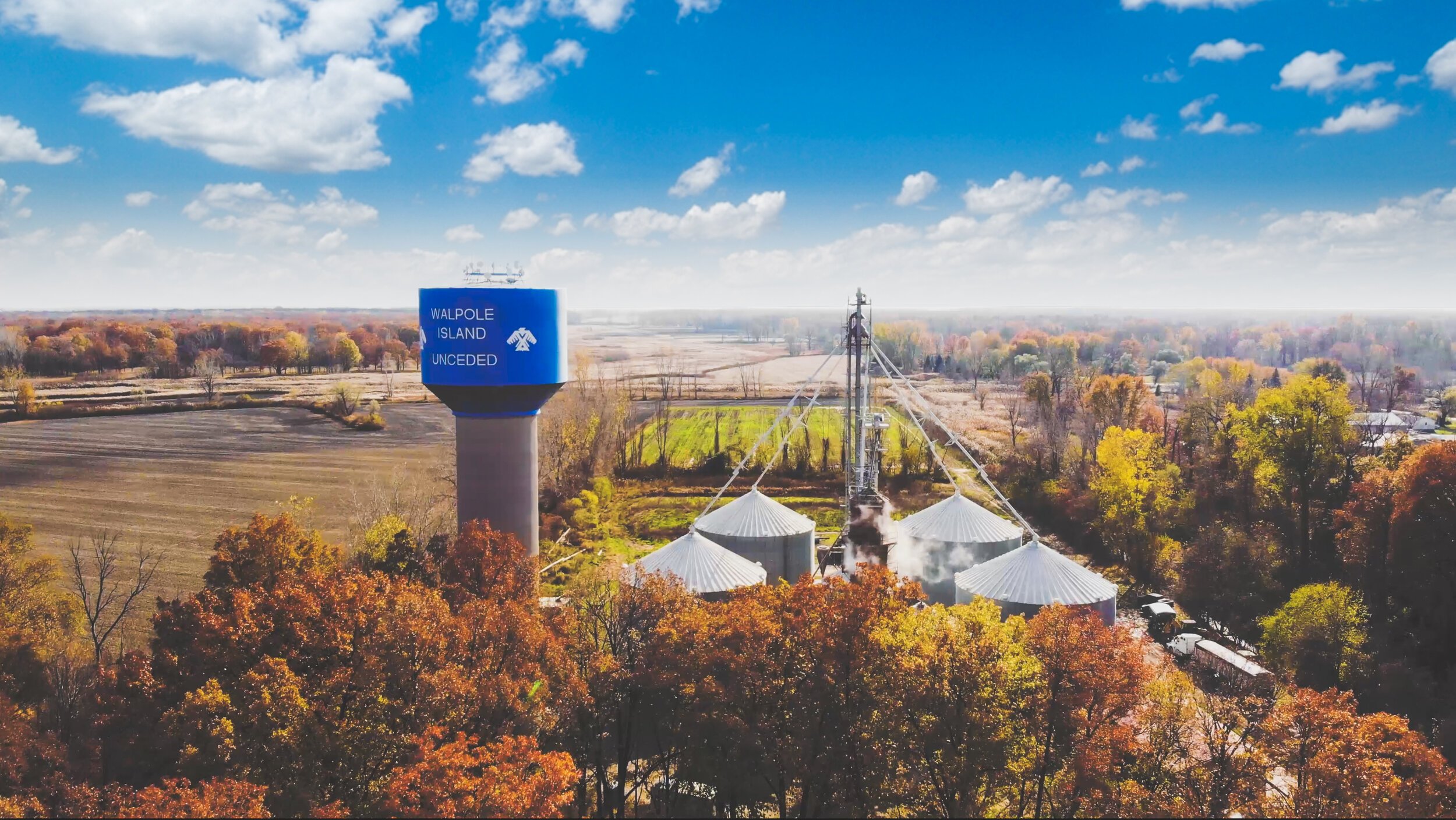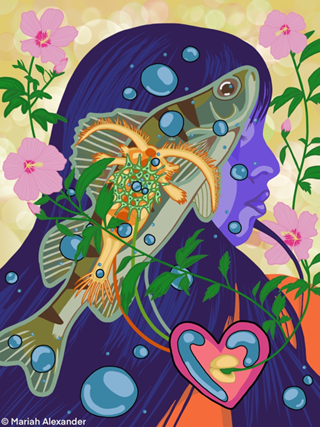Why Do Birds Bring Us So Much Happiness?
Spring has sprung at HHL! As the signs of spring bloom around us we want to reflect on the happiness that spring brings us. Environmental Artist Mariah in collaboration with our Ode’imin/IKC founding Director Candy has written a beautiful piece on our relationship to birds, one of the first signs of spring. We invite you to reflect with us as we move into our spring season.
This is one of many ways Mariah’s creative artistry and gifts have been celebrated and honoured here at HHL. Check out more of Mariah’s recent work as part of Black History month here, Ojibway colouring book here, Ecosystem Approach project page here, and I am one with everything here. Chi-miigwech Mariah for sharing your gifts with us! We can’t wait to see what else blooms on this journey together. ~ HHL
Why Do Birds Bring Us So Much Happiness?
By Mariah Alexander, Environmental Artist for the Healthy Headwaters Lab
We hear their songs with the rising sun that let us know we have all made it to the beginning of a new day. We feed them, watch them, and enjoy their colourful presence on a daily basis. We do this because we love the Bird Nation.
Birds have been on the earth for much longer than humans. One of the oldest known fossil records of birds discovered by Spanish and Argentine paleontologists date back to the early Cretaceous period, making them approximately 150 million years old (Monastersky, 1988). Oral histories of the Anishinaabeg First Nations state that in the creation of the earth, the Creator sent the Bird Nation to seed all plant life so that life could be supported there (Dodge, n.d.), which suggests that birds have been on the earth for a very long time.
The birds around us provide people with a great deal of happiness. Articles shared by Nairn (2020) and BirdWatching (2020) have found that greater bird diversity brings joy to people and concluded that conservation of their environments is therefore tied to human well-being. Living thru the global COVID-19 pandemic has taken a toll on the physical and emotional well-being of many people, but seeing and hearing birds has provided “an antidote to despair” that can be seen through the incredible rise in bird food and supply sales (Zarrankin, 2021).
By https://www.flickr.com/people/sherseydc/ - https://www.flickr.com/photos/sherseydc/2838396776/, CC BY 2.0, https://commons.wikimedia.org/w/index.php?curid=5100377
After reviewing the articles mentioned above, I began to reflect on the question “why does seeing and hearing birds bring us so much happiness?”. The purpose of this article is to articulate deeper explanations as to why birds bring people happiness. Before we get into it, I would like to acknowledge my positionality. I am an Anishinaabeg-Black-Mexican-English, female youth living on Walpole Island First Nation. I have a Bachelor of Arts Honours Degree in Environmental and Resource Studies. My lived experiences, conversations with friends and community, Indigenous cultural knowledge, and educational background influence the content within this article.
Birds bring us happiness for cultural, personal, and environmental reasons. Firstly, for Anishinaabeg people, seeing various species of birds reminds them of many positive teachings or stories. Ozaawaashiinh, the Yellow Finch, is known as a keeper of Anishinaabemowin (the Ojibwe language); Migize, the Eagle, flies the highest and carries prayers and messages to our Creator. The call from the crow reminds me of one of my favourite stories:
American Crow - CC BY-SA 3.0, https://commons.wikimedia.org/w/index.php?curid=2310490
A long time ago, Nenaboozhoo, a cultural hero in our oral histories, was tasked with painting the birds and giving them their fancy colours. The crow kept going to the back of the line to see all the other birds colours first, they wanted to take all the best ideas and request them for themself. By the time Nenaboozhoo got to the crow, the colours had been all used up and only black was left. As Nenaboozhoo dunked the crow into the black paint, they cried “KAA, KAA!”. “Kaawiin” or “gaawiin” is the Anishinaabeg word for no.
We hold these teachings close, and when we see the birds they are about we fondly remember the stories and the people we heard them with, as well as our elders who carried them through time.
For many Indigenous peoples, birds also bring us joy because we associate them with good leadership, responsibility, and respectful behaviours. Chiefs in various cultures are adorned with headdresses made with bird feathers, and dancers similarly wear feathers as part of their regalia. There are also bird clans, like Eagle and Crane clans, and to those that are a part of these clans, encountering one of these birds can feel “like a special visit from a relative checking in on me, and act as a reminder of connections and responsibilities [to community]” (Caddotte, 2021). Our kin that we hold in high regard - the chiefs, dancers, healers, clan animals - are connected to birds. Seeing specific birds brings Native people a sense of protection, respect, and joy when they meet them.
Another cultural importance of birds is the livelihood they provide us. My First Nation, Walpole Island, is situated within a delta island complex along Lake St. Clair. Walpole Island contains 17,000 acres of internationally recognized World Class wetlands that are perhaps the largest in the Great Lakes basin (Walpole Island Heritage Centre, 2006). These wetlands and the waterfowl that inhabit them are a source of livelihood as they provide economic, physical, and emotional benefits to members of the community. Waterfowl are hunted to provide food for families, and extra meat and feathers can be sold for income or gifted to others. The time spent on the land to obtain waterfowl resources provides the hunter with physical exercise and can balance or improve their moods.
Image by Walpole Island First Nation https://www.walpoleislandfirstnation.ca/
Moving beyond culturally specific reasons, birds are a source of deeply personal connections and inspirations for people. A lot of people in my life have expressed that they connect certain birds to loved ones both passed-on and present. For example, one of my friends told me “when I see a cardinal I remember my mémé and I like to think it is her visiting me” (Lozon, 2021); my father thinks this too about cardinals, but it could be a different bird for different people. My mother loves birds so much that she gave me the middle name “Bneshiins” which means Little Bird, and when I see little birds I remember her, who I am, and also my connection to my younger brother whose spirit name is Little Bird. Birds connect you to those loved ones - birding or feeding the birds in your yard is pass time that you spend together. Poets and lyricists have written wonderful words, and dancers at the powwow do the crow hop and chicken dance all because of the inspiration from birds. Birds connect us to people and experiences around us and demonstrate symbolic meanings such as hope, freedom, and resiliency that people used to express themselves.
There are also ecological reasons that birds bring us happiness. Where we see a lot of birds, we know that there is great diversity in the natural areas around us. Knowing this brings a sense of healthiness, safety, and peace with our homelands. Some Native people also believe if you see a Blue Jay while hunting deer, the deer are close by (Soney, 2021). Furthermore, when we see the birds flocking or hear a Robin singing, we become excited because we know warmer and brighter days are approaching. The ecological information that birds brings happiness through the feelings of reassurance and anticipation they evoke.
As humans we have an inherent desire to form relationships because they are important to our mental and emotional well-being. A beneficial relationship to us requires listening to each other, communicating without judgement, trust, respect, and consistent time together (Northwestern Medicine, 2021). We experience these kinds of relationships with birds:
“I like observing which ones come and go throughout the seasons, how you expect different ones depending on where you are, their delicate choreographed movements, their resilience to harsh conditions, how different their individual nests are, the intricacies of their songs, how many different songs they each have, and their unbelievable beauty. In school, examining feathers close up was this astonishing look into the perfection of design, how many different types of feather are on each bird serving a different purpose” (Keeshig, 2021).
We provide feed and housing for them, and we learn the regulars in our yards and their migratory patterns. We see their life cycles from eggs to young birds learning how to fly and find food. To us, they give us happiness, spread seeds in our yard, and sometimes even communicate to us through calls and gifts. “Paying attention is a form of reciprocity with the living world”, we receive “the gifts with open eyes and open heart” (Kimmerer, 2013). As an artist, watching and reading about birds has inspired me to create pieces about them.
To sum it all up, birds bring us happiness for a multitude of environmental, cultural, and personal reasons. Our experiences and relationships to birds that bring us happiness are both shared by others and highly individualized. I agree that the bond we share with birds provides another important reason for conservation of ecosystems, but I also believe it is one of the reasons that provokes us to care for the environment in the first place; “Knowing that you love the earth changes you, activates you to defend and protect and celebrate. But when you feel that the earth loves you in return, that feeling transforms the relationship from a one-way street into a sacred bond” (Kimmerer, 2013).
The colouring book honours our Relations that live and create Ojibway Park and Bkejwanong. The book features the Anishnaabemowin language Indigenous to the Land where the Ojibway Nature Centre sits. - Candy Donaldson
In this colouring page created by the artist, the Tufted titmouse sits on a branch. This is one page from a colouring book created for the Ojibway Nature Centre that can be found on our HHL, Artist and ONC websites.
About the Artist
Indigenous artist, Mariah Alexander *Baashkooniingad Kwe.
Mariah is a recent B.Sc. graduate in environmental and Indigenous studies from Trent University, and as a recent grad, she spent much of the summer working alongside Indigenous youth engaged in the Bkejwanong Eco-Keepers and part of a community-based effort to rematriate native Walpole Island corn back to its ancestral lands for the first time in generations. She will continue to be mentored by artists in the Incubator Lab, engage with the Healthy Headwaters Lab’s research underway at Bkejwanong, and work in her community.
Drawing by Mariah Alexander
*Baashkooniingad Kwe translates to “buds on the tree beginning to open woman” in Anishinaabemowin, the Anishinaabe/Ojibwe language.
References
BirdWatching. (2020). Birds increase human happiness, study finds. Retrieved from https://www.birdwatchingdaily.com/news/birdwatching/birds-increase-human-happiness-study-finds/.
Caddotte, A. (2021). Personal communication about seeing your clan animal.
Dodge, T. (n.d). Personal communication of the Anishinaabeg creation story.
Kimmerer, R. (2013). Braiding Sweetgrass: Indigenous Wisdom, Scientific Knowledge and the Teachings of Plants. Milkweed
Lozon, T. (2021). Personal communication about happiness birds bring people.
Monastersky, R. (1988). Bird Fossil Reveals History of Flight. Science News, 133(7), 102. Retrieved January 24, 2021 from http://www.jstor.org/stable/3972285.
Nairn, C. (2020). Study: Birds Are Linked to Happiness Levels. Retrieved January 24, 2021 from https://www.ecowatch.com/birds-happiness-study-2649413979.html.
Northwestern Medicine. (2021). 5 Benefits of Healthy Relationships. Retrieved January 24, 2021 from https://www.nm.org/healthbeat/healthy-tips/5-benefits-of-healthy- relationships.
Soney, D. (2021). Personal communication about happiness birds bring people.
Walpole Island Heritage Centre. (2006). Species at Risk on the Walpole Island First Nation. Walpole Island Heritage Centre Natural Heritage Program.
Zarankin, J. (2021). More Birds Brings More Happiness, According to Science. Retrieved
January 24, 2021 from https://www.audubon.org/news/more-birds-bring-more-happiness-according-science.






